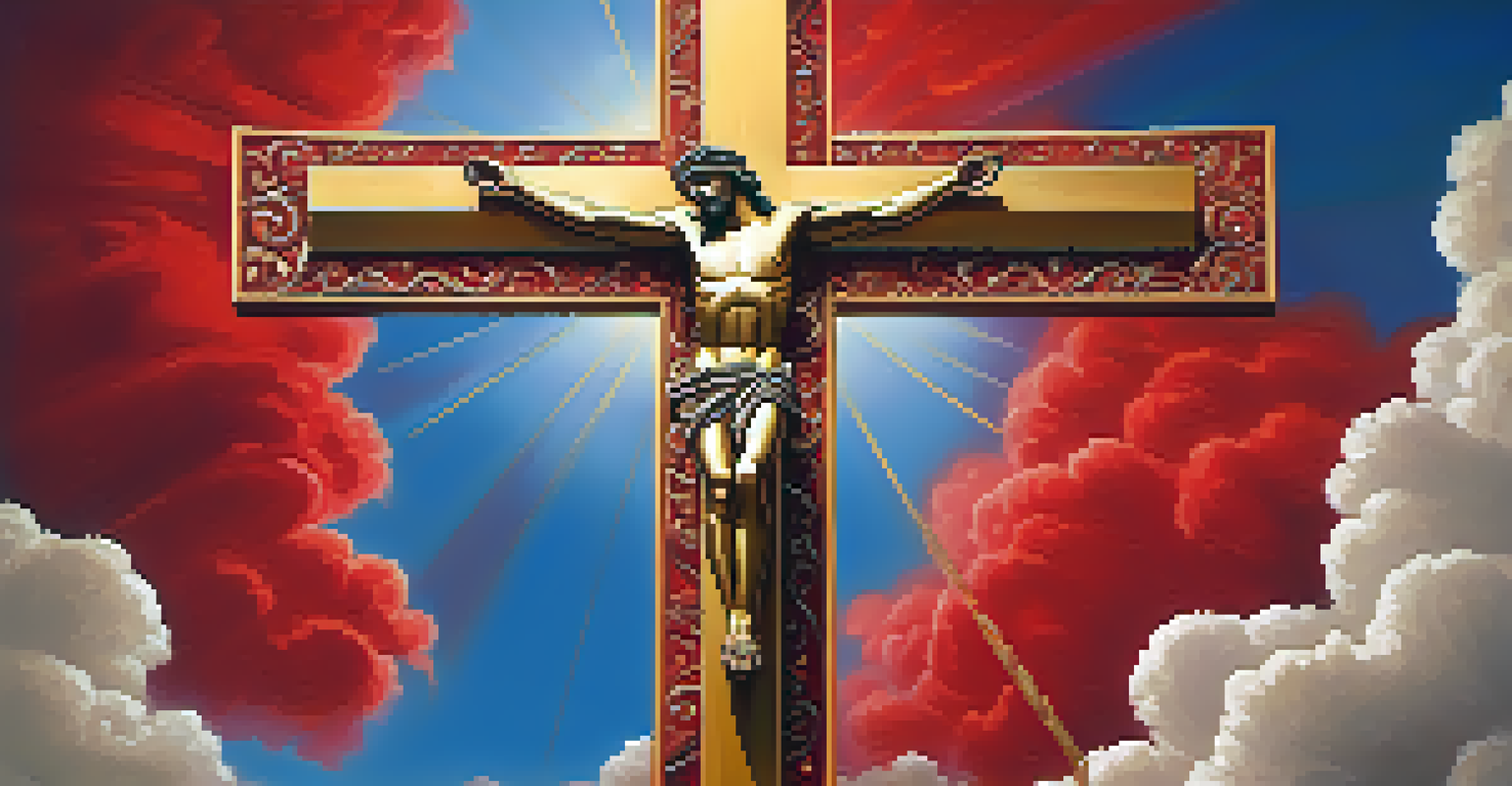Understanding Iconography in Religious Paintings: A Deep Dive

What is Iconography and Why is it Important?
Iconography refers to the visual images and symbols used in art, particularly religious art. It serves as a language that conveys complex spiritual ideas and beliefs through easily recognizable symbols. Understanding iconography is crucial for interpreting the deeper meanings behind religious paintings, as it connects the viewer to the narrative and themes of the artwork.
Art is the most beautiful of all lies.
For instance, a painting of the Virgin Mary may include symbols like the lily, representing purity and motherhood. These elements enrich the story being told and invite viewers to engage with the artwork on a more profound level. Without grasping these symbols, one might overlook the nuances that the artist intended to communicate.
Moreover, iconography creates a shared visual vocabulary across cultures and time periods, allowing diverse audiences to connect with the spiritual messages conveyed. By studying iconography, we can appreciate the artistry and intention behind these significant works, enhancing our overall understanding of art history.
Common Symbols in Religious Iconography
Many religious paintings feature commonly used symbols that carry specific meanings. For example, the cross is a prominent symbol in Christianity, representing sacrifice and redemption. Similarly, the halo often signifies holiness and divine favor, appearing around the heads of saints and holy figures in various traditions.

In Hindu art, the lotus flower symbolizes purity and spiritual awakening, often depicted in scenes involving deities. Each of these symbols not only adds aesthetic value but also communicates essential beliefs and teachings of the faith. Recognizing these symbols allows viewers to grasp the underlying messages more clearly.
Understanding Iconography's Impact
Iconography serves as a visual language that conveys complex spiritual ideas, enriching our interpretation of religious art.
By familiarizing ourselves with these common symbols, we can navigate through the rich tapestry of religious art with greater ease. This understanding deepens our appreciation for the artwork and the cultural contexts from which they arise, making our viewing experience much more enriching.
The Role of Color in Iconography
Color plays a significant role in religious iconography, often conveying specific meanings and emotions. For example, blue is frequently associated with the divine and heavenly realms, making it a popular choice for portraying figures like the Virgin Mary. In contrast, red can symbolize sacrifice, love, or the passion of Christ, depending on the context of the artwork.
A picture is worth a thousand words.
Artists intentionally select colors to evoke particular feelings or to highlight important aspects of the narrative. This thoughtful use of color not only enhances the visual appeal of the painting but also serves as a tool for storytelling. Viewers can often glean emotional depth and significance by considering the colors present in a piece.
Understanding the symbolism behind colors helps us appreciate how artists communicate ideas beyond the surface. By examining the colors used in religious paintings, we can uncover layers of meaning that contribute to the overall message and enhance our connection to the artwork.
Cultural Influences on Iconography
Iconography is not created in a vacuum; it is deeply influenced by the culture and society in which it originates. Different cultures interpret symbols in unique ways, resulting in diverse representations of similar themes. For example, the depiction of angels varies between Western and Eastern art, reflecting differing cultural beliefs and artistic traditions.
Additionally, historical events and societal changes can shape iconography over time. As cultures evolve, their religious art may adapt to reflect contemporary values and issues, making the study of iconography a fascinating exploration of cultural history. These influences remind us that art is a living dialogue between the past and present.
Cultural Context Shapes Symbols
The meaning of symbols in iconography varies across cultures, reflecting unique beliefs and artistic traditions.
Recognizing the cultural context of iconography enriches our understanding of religious paintings. It highlights the interconnectedness of art, faith, and society, allowing us to appreciate how these elements influence one another throughout history.
Iconography in Different Religious Traditions
While iconography is commonly associated with Christianity, it exists in various forms across different religious traditions. In Buddhism, for example, iconography is used to convey the teachings of the Buddha through images and symbols, such as the lotus or the Dharma wheel. Each symbol has a specific significance, helping to communicate core concepts of the faith.
Similarly, Islamic art often employs geometric patterns and calligraphy instead of figurative representation, reflecting the belief in the transcendence of the divine. This choice of iconography invites contemplation and emphasizes the beauty of creation without depicting living beings. Understanding these differences broadens our perspective on how various cultures express their spirituality through art.
By exploring iconography across different religious traditions, we can appreciate the rich diversity of human expression and the universal quest for meaning. This understanding fosters greater respect and appreciation for the beliefs and practices of others, enriching our own spiritual journeys.
The Evolution of Iconography Over Time
Iconography is not static; it evolves over time, reflecting changes in theological beliefs, cultural contexts, and artistic styles. For instance, during the Renaissance, there was a shift towards more humanistic representations of religious figures, emphasizing their humanity alongside their divinity. This evolution in iconography allowed artists to explore new ways of connecting with viewers on a personal level.
As societies change, so do the symbols and themes depicted in religious art. Modern interpretations of ancient symbols can offer fresh perspectives and new meanings that resonate with contemporary audiences. This adaptability of iconography illustrates the dynamic relationship between art, faith, and society throughout history.
Iconography Evolves with Society
As cultural contexts and theological beliefs change, iconography adapts, allowing it to resonate with contemporary audiences.
Studying the evolution of iconography helps us understand how religious beliefs and cultural contexts shape artistic expression. It allows us to trace the development of ideas and practices over time, revealing the rich narrative that connects past and present.
Interpreting Iconography: Tips and Techniques
Interpreting iconography can feel daunting, but there are several tips and techniques to make the process more accessible. Start by familiarizing yourself with common symbols and their meanings, which can serve as a helpful foundation for understanding specific artworks. Additionally, consider the context in which the artwork was created—historical, cultural, and personal factors can all impact the iconography present.
Another useful approach is to look for patterns and repetitions within the artwork. Notice how certain symbols might interact with one another and what that might reveal about the overall message. Engaging with the artwork in this way encourages a deeper contemplation of its meanings, making the experience more enriching.

Lastly, don’t hesitate to seek resources—books, articles, or even guided tours—that explore iconography in more depth. The more you learn, the more rewarding your engagement with religious paintings will become, opening up a world of spiritual and artistic exploration.